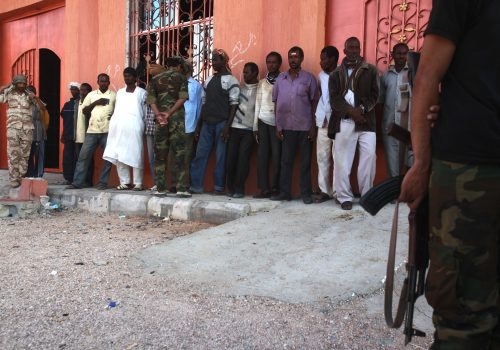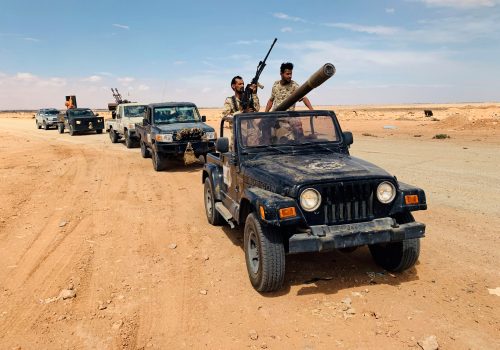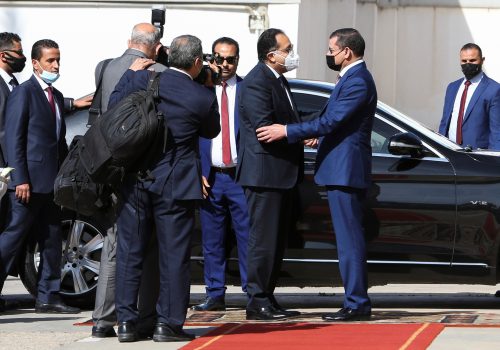Libya’s fragile ceasefire: A lost opportunity?
On April 16, the United Nations Security Council unanimously adopted Resolution 2570, approving arrangements for a ceasefire monitoring mechanism and the deployment of United Nations monitors. Sixty civilians were approved for the ceasefire monitoring team to work alongside the 5+5 Joint Military Commission, which is made up of five military officers from the Libyan Army/Operation Volcano of Rage and five from General Khalifa Haftar‘s Libyan National Army (LNA). But will a sixty-person team be sufficient to prevent the renewed outbreak of hostilities in this deeply split country?
The current situation in Libya
The establishment of a new Presidential Council and a Government of National Unity headed by Prime Minister Abdulhamid Dbeibha, fully endorsed by Libya’s legitimate parliament, the House of Representatives, is a major step in the right direction after a decade of civil war. General elections are scheduled for December 24, 2021. However, Libya has neither a constitutional basis nor an electoral law. The lessons from the 2014 parliamentary elections, which were a main trigger for the subsequent escalation, must not be forgotten.
Dbeibha, an experienced businessman without a military background, is mainly focused on economic recovery: fighting the coronavirus, managing the electricity crisis, improving the living circumstances of the population, and jumpstarting the economy. Compared with last fall, the security situation in Libya’s northwestern region of Tripolitania remains unchanged. In some areas, like the capital Tripoli, it became even worse. The crime rate is very high and there is frequent fighting between various gangs and militias. Until now, Dbeibha and his interior minister, who have—contrary to former Interior Minister Fathi Bashagha—no direct control over powerful fighting units and did not act against the numerous militias, who are all somehow legitimated as “security forces.”
The military situation
The ceasefire agreement between the Libyan Army and LNA works for the time being, although next to none of the additional provisions have been implemented. Opposing forces are still facing each other in the Sirte-Al Jufra region, a strategically important Oil Crescent, from where more than half of Libya’s crude is exported.
Major fighting is currently unlikely, but the risk of renewed and larger hostilities at a later stage remains, possibly triggered by opposing militia groups sharing a deep distrust of one another. Turkey and Russia continue to maintain—contrary to the ceasefire agreement—a significant military presence in Libya. While, on one side, Operation Volcano of Rage launched by the GNA needs Turkish support to maintain the military option of an advance towards the east, the currently weakened LNA relies on the Russians to defend against an eventual surprise attack. Egyptian President Abdel Fattah al-Sisi declared a “Red Line” from Sirte to the Al Jufrah Oasis (230 km further to the south in the Sahara Desert) in June 2020 to prevent eastern Libya from falling into the hands of the GNA and Turkey. With Egypt still threatening to intervene if this red line is crossed, a return to war could easily lead to a regional escalation.
Nevertheless, the current favorable political situation provides an opportunity to consolidate the ceasefire, but maybe it is just a window of opportunity, which could close again.
The need for an efficient UN monitoring mission
At best, a future monitoring mission could provide a reliable picture of the military situation, including ceasefire violations, the withdrawal of foreign forces, and help build confidence between the warring factions. At worst, the mission can be merely symbolic with having just sixty observers advise and monitor an area the size of Maryland. To compare, the observer component of MINURSO, the UN Mission in the much calmer Western Sahara, numbers 520 military and civilian personnel to monitor an area twice the size of Maryland in the country’s north and four additional team sites further in the south. It’s also worth noting that most Libyans are not eager to have a large international mission in their country—let alone a military mission.
Still, there is a need for credible international monitoring. While no civilian mission can deter a renewed outbreak of hostilities, it could—if properly equipped, organized, staffed, and supported—identify which side was the initial aggressor. In combination with serious political implications for the branded aggressor, both sides would raise the threshold. To be efficient, Libya must have a couple of hundred civilian observers and long-range stand-off radar and electronic surveillance from the sea. This should be outside of Libyan territorial waters and/or from very high altitude.
This surveillance could be provided by satellites and American assets deployed already in the Mediterranean. For detecting low-flying aircraft, Airborne Early Warning would be needed. While the United States does not have any of these systems permanently based in the region, European allies have such aircraft in their inventory. Sharing the burden, the ongoing EU Operation IRINI—established to enforce the arms embargo at sea—could provide many of the required platforms while remaining entirely outside of the Libyan territory.
A chance for a new Western role in Libya
The instability of Libya is a threat to national interests in the wider region. Terrorist and rebel groups still use the southern part of the country as a base for their operations throughout Africa—e.g. destabilizing Mali, Burkina Faso, Niger, Chad, and Nigeria. A return to war and an eventual uncontrolled disintegration of Libya could further aggravate the situation, as the recently released “Annual Threat Assessment of the US Intelligence Community“ confirms. Now the US has the chance to push for efficient monitoring and to contribute to Libya’s success with limited, but sophisticated, technical means.
A significant contribution by the Europeans could help to raise their influence in Libya. While France and Italy have their differences, the stabilization of the ceasefire is something all countries can agree upon. Keeping the 2011 NATO-led military intervention in mind, Europe also must maintain its engagement with Libya.
The current political climate is an opportunity to consolidate the ceasefire. If this chance to end hostilities once and for all is not taken, it could be lost. In cooperation with enough civilian observers on the ground, stand-off surveillance would allow actors to clearly identify any violators of the ceasefire, while taking the sensitivities of the Libyans into account.
After the ceasefire is consolidated and a demilitarized zone is monitored, it should be more realistic to get foreign forces out of Libya, as their main justification is the perceived existence of a military option from the “other side.”
The situation in Libya is precarious. A consolidation of the ceasefire would help buy more time for the country’s prime minister. Sidelined by Turkey and Russia, this chance should not be missed by the US and Europe.
Wolfgang Pusztai is a director of Perim Associates. He is also the chairman of the Advisory Board of the National Council on US-Libya Relations (NCUSLR) and senior advisor to the Austrian Institute for European and Security Policy (AIES).
Image: Troops loyal to Libya's internationally recognised government gather to break their fast during the holy month of Ramadan, in Abu Grein, Libya April 29, 2021. Picture taken April 29, 2021. REUTERS/Ayman Al-Sahili


